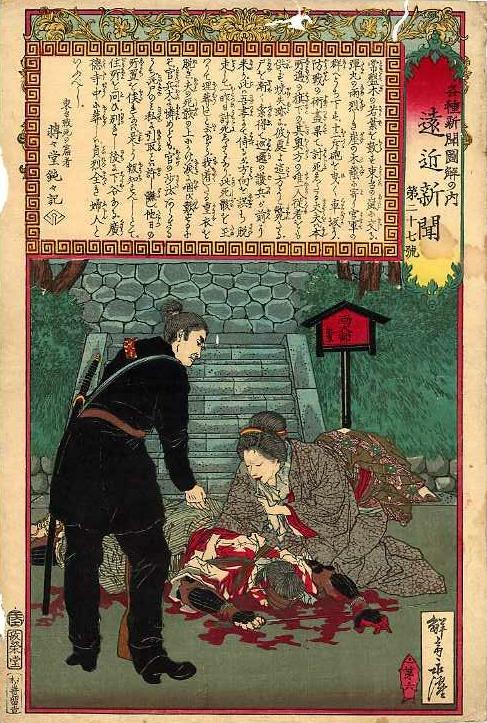Sensai Eitaku
Kobayashi Eitaku (1843-1890) was one of the most talented drawers of the Meiji period. The entire KSZU series, but especially this Shogitai print, shows an originality of composition and color seldom seen in contemporary woodblock prints.
In the most somber yet vivid colors, and in very realistic lines, Eitaku depicts a government soldier sympathetically standing by as a woman kneels over the bloody body of her husband at the foot of the stairs of Ryodaishi temple on Ueno Hills, then part of the grounds of Kan'eiji temple, now Ueno Park. The soldier had helped the widow find her husband, who had fallen in a "rain of bullets" (tama no ame) fired by government troops on members of the Shogitai, the last remnant of Tokugawa loyalty in Edo at the dawn of the Meiji period. (Shimonaka 1979.1:24; Ono 1972:105, 175).
Ono Hideo waxed almost elegant about the comparatively unknown Eitaku (Ono 1972:8-9).
|
Eitaku, whose real name was Kobayashi Shutaro, was born in Edo in the 14th year of Tenpo (1834). His family sold fish, but early on he studied the Kano Eitoku style of drawing and was patronized as a Kano-school drawer by the House of Ii of daimyo fame. Later he moved to Tokyo and turned to drawing pictures of customary life. After this, he drew customary scenes in the ukiyoe style, but he never lost his Kano-school methods. Compared with Utagawa-school drawings, his are said to lack softness. However, compared with Yoshiiku who adopted bold colors, and with Yoshitoshi who imitated Hokusai-style lines, there is the added flavor of an oil painting in Eitaku's drawings. On this point, his drawings are totally different from those of the two Utagawa-school ukiyoe drawers. |
Eitaku later worked as an illustrator for Eiri jiyu shinbun, and Ono says his newspaper line drawings showed the same tendencies toward realism and calmness. (WW)
Tentendo Dondon
The story on the print is signed Tentendo Dondon, who wrote all the stories in the KSZU news nishikie series drawn by Saisen Eitaku. Tentendo Dondon is a pen name of Takabatake Ransen, who wrote the story on Yoshiiku's Shogitai nishikie (TNS-689). Takabatake did most of the stories for Yoshiiku's TNS prints, but he usually signed them Tentendo Shujin (his most common pen name on woodblock prints) or Tentendo Dondon. Yoshiiku's Shogitai print is the only print in the TNS series that he signed Takabatake Ransen, the name by which he was best known as a gesaku writer.
I would guess that Takabatake affixed his gesaku name to Yoshiiku's Shogitai print because the story he wrote for it was a very personal one: he had co-authored a collection of Shogitai stories and had paid his respects during the 7th memorial rites.
Whereas here Takabatake is merely retelling a story reported shortly after the battle, in a by then defunct "news magazine" called Ochikochi [Enkin] shinbun (Hear and there [Far and near] news).
Movie tie-in
In the 1991 movie Fukuzawa Yukichi, directed by Sawai Shin'ichiro and starring Shibata Kyohei as Fukuzawa, some of Fukuzawa's students had gone to join the battle, despite Fukuzawa's preaching that "the pen is mighter than the sword".
One of those who joins the battle is a samurai named Shinohara (played by Nakamura Tooru), who had broken up with Nobu (Minamino Yoko), his prostitute lover. On his way to Ueno, Shinohara goes to Nobu's home, and leaves with her family a note on which he has written "I Love You" in English and in blood. Receiving the note, and hearing the battle, Nobu heads for Ueno to find Shinohara, who has been wounded and is stumbling through corpses as though blinded by the blood on his face. When Nobu finds him, he appears to be dying if not already dead. As the movie ends, we see him attending one of Fukuzawa's lectures, with Nobu at his side, assisting him with his notes, as he is blind.
Print information
Series: Kakushu shinbun zukai no uchi
Number: 6
Source: Ochikochi shinbun No. 27, circa Keio-4-5-30 (19 July 1868)
Date: 1874-11 (seal)
Publisher: Seieido
Drawer: Sensai Eitaku (Kobayashi Eitaku)
Carver: Matsuzaki Ryukichi
Writer: Tentendo Dondon (Takabatake Ransen)
Size: Oban
Image: Yosha Bunko
Principal sources
Ono 1972:175 (Plate 106)
Tsuchiya 2000
